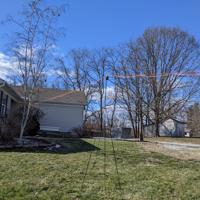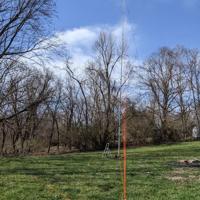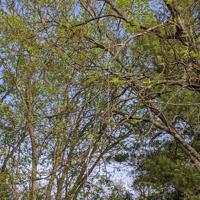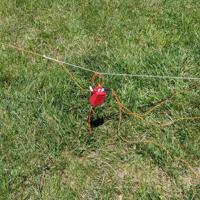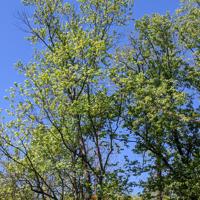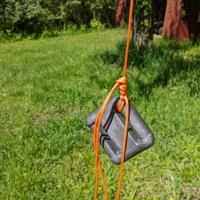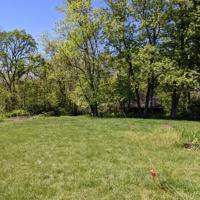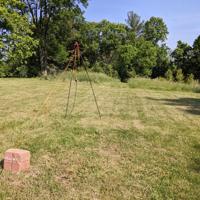Antenna Rigging
A few months ago, I obtained an amateur radio license, general class. This opened up longer bands, and in turn, longer antennas. Typically, longer the antenna, the higher it should be above ground.
This requires a bit hard knocks in rigging cordage. This page is more a set of notes, rather than a narrative. These are all stated as my opion, not hard facts.
Nautical / Sail terminology is best intent, as it’s a slightly different context.
Don’t Do Dumb Shit!
First things first:
- Amateur radio involves dangerous amounts of voltage. Radiator assemblies be must out of reach of pets, children, and power lines.
- Cordage under tension can contain dangerous amounts of energy. Add lightness, not tension. Do not attempt to tie knots under load.
- This is for temporary antenna installations. 100w PEP is assumed.
- All radiating elements are insulated stranded copper.
- NFPA applications are required to use at least 12 awg.
- Copper clad aluminium, while lighter, and cheaper, should be avoided due to fragility.
Cordage
There are two main types of line that I have found useful; braided, and kermantle / paracord. Both are available in hi-viz formats.
Twisted should be avoided, as it gets unruly under under load.
Braided:
- Nylon or Polyester / Dacron. Typically in #18 or #24 weight.
- Nylon has more ‘bite’, and is useful for anchoring radiating elements. The traditional ‘Cave Line’.
- Polyester braid typically has less stretch, and is useful for messenger or support lines.
- Larger braid (3/16”), poly is used as arborist throw line.
- 100lb+ typical test strength
Kermantle / Paracore
- Internal bundle, with external sheath.
- Useful for high abrasion situations.
- 550lb typical test strength
Sourcing
I have been quite happy with Sgt Knots for all cordage needs.
18 AWG, whatever you can get your hands on really.
Again, upgrade to 12 awg if used within NFPA covered applications.
Random bits
General Use Knots
Halter Hitch
Quick release hitch, used to attach cordage to branches or other hardware.
Tumble Hitch
Alterantive to Halter Hitch. More secure under load.
Surgeon Knot
Single overhand, secured with double overhand. Securing two pieces of cordage under tension.
Figure 8
Used for creating a loop in the working end, or as end of line dressings.. Personally prefer it over the bowline due to it being more tidy.
Double Overhand / Fisherman’s Bend
This knot is used extensively throughout all of my rigging..
A Fisherman’s bend is two opposing Double Overhands..
Can be adapted as a hitch by tying a double overhand after wrapping around the attachment point.
A slip variant can be done by pulling a bight instead of the working end through.
Blood Knot
Strange cousin of the Fisherman’s Bend. Used for splicing or repairing cordage.
Assemblies
Prusik Loops
A loop of cordage, connected to itself via a fisherman’s bend.
Terminating Elements
A single, or running, double over hands may be used to terminate a wire element.
After the wire is attached, cut an arm span of cordage to have a working end.
Halyards
Line terminated in a pulley. Used to avoid wear on trees, and provide a smooth action for counterweights.
My halyard assemblies consist of a 125’ paracord lift line, a 50’ paracord guy, and a 50’ #24 dacron tagline. This allows for a 50’ high tree anchor point, with up to a 50’ stand off from the anchor.
Messenger Line
In my experience, plain old cheap 18 awg stranded wire is quite happy up to about 4lb tension. Above that the insulation starts creeping. This seems plenty for up to around 50 of 18 awg.
For longer spans, using a messenger line of #24 dacron braided line can be used. This line is attached via 3d printed PETG clips to the antenna elements, which are allowed to freely move in relation.
Alternatively, copper clad steel line could be used. I personally prefer stranded copper due to it’s pack ability when not in use.
Applications
Single Lift, Center
Inverted V Dipoles, and Doublets; Verticals.
Simplest of rigging.
- Loft a line over a tree, or branch
- attach to center block
- lift, and anchor
- tension legs via weights on ground.
a single lift point can generally be done static. Allow enough slack in the lifted assembly for any movement of the supporting structure.
Single Lift, End
More complicated than a center lift, as sway from trees must be accounted for.
I typically anchor with a 4lb weight on the lift line, and a 2lb weight on the antenna guy.
Well suited for end fed random wires!
- Anchor feed end via available means
- Loft a halyard over a tree
- Attach free end of antenna to halyard
- Attach counterweight to halyard
- lift, and anchor
Another option is to fix the far end to a tree without a counterweight, and then use a weight assembly on the near side.
Double Lift
Use for spans longer than 100’. I typically anchor with one or two retaining wall bricks (20lb?) on the lift line, and a 4-8lb weight on the antenna guy.
- Loft a halyard at far end
- lift far end of antenna, and static anchor
- loft a halyard at near end
- attach near end to halyard
- attach counterweight to halyard
- lift and anchor halyard
Stowage
Three wraps around hand, then figure 8 over arm
Smaller amounts can be figure 8 over hand
